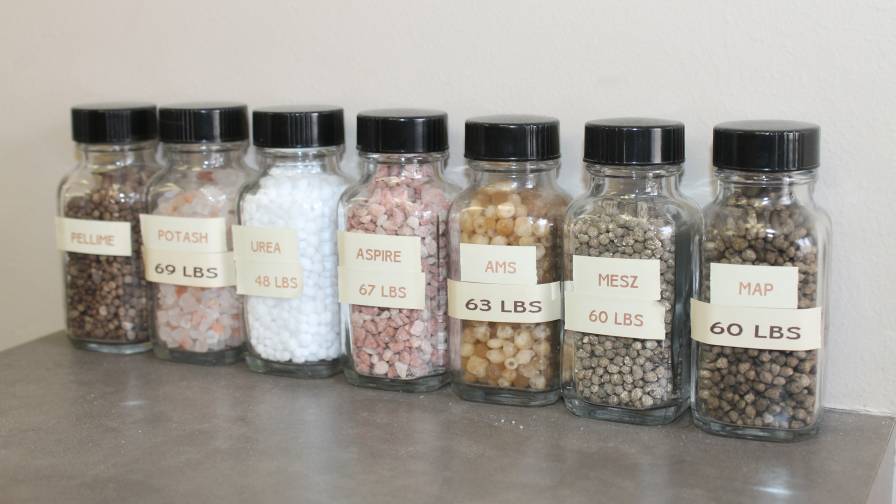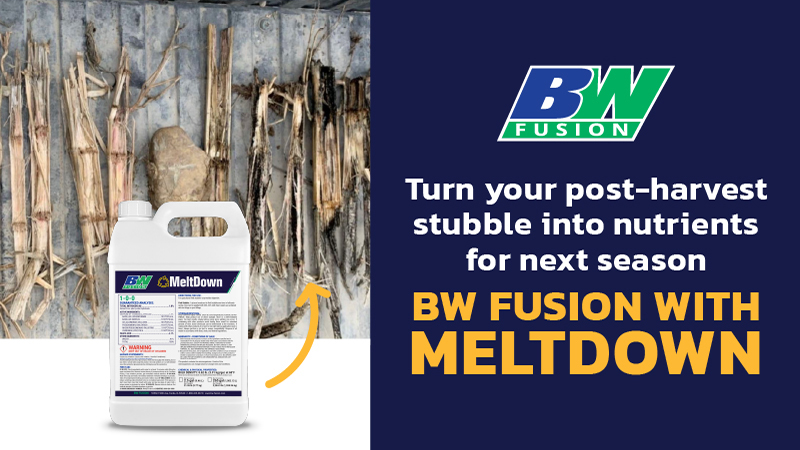Crop Nutrition: The Outlook for Fall Fertility Remains Strong

Despite depressed economic data and higher-than-anticipated production costs, the quest for more yield is expected to keep crop nutrient demand up this autumn.
For ag retailers counting on crop nutrition application, it’s almost an annual rite of passage. Usually going into the spring season, there’s cautious optimism that market conditions will be just positive enough to spur strong demand among grower-customers. In the end, most ag retailers take a “middle of the road” attitude towards their fertilizer application outlook.
“I am very neutral so far as fertilizer application goes for 2024,” said George Secor, President/CEO at Sunrise Cooperative, Fremont, OH, during a late December 2023 interview with CropLife® magazine. “Growers had plenty of carryover money from 2022 and our fall application was very good, but I am very concerned when we really study budgets what will happen in 2024. Most budgets here in the Eastern Corn Belt will be in the red when we plug in $5.06 corn and $12.63 soybeans.”
Of course, observed Secor, this focus on crop prices is almost always the key driving factor for fertilizer application decisions. “As we look back, the past two years have been almost polar opposite kind of years,” he said. “2022 prices ran up almost all year long. On the other hand, in 2023, it seemed like whenever retailers stepped up and bought something, it declined in value. Growers are proactive about managing risk for the crops they are growing not only in 2024, but they want to manage risk for the 2025 crops as well.”
Once spring application season ends and ag retailers begin looking ahead to the fall, their attitudes tend to improve, especially if the agricultural market outlook has improved somewhat from the usual early summer doldrums.
So, now that the industry is gearing up for the 2024 fall crop nutrient application season, is this the pattern ag retailers are seeing beginning to form? In a word, yes.
During our latest survey of the nation’s largest ag retailers in preparing this article, CropLife magazine once again asked Sunrise’s Secor how he expected the market to play out over the upcoming months, and on into 2025.
His answer speaks for itself.
“This one is fairly straightforward,” he says. “Here in Ohio, we have a very good crop coming at us. Throughout my career whenever we see big yields, we also see very strong fertilizer applications as growers return to the soil what they have pulled off. Sunrise has also helped position many of our customer-owners with purchasing fertilizer earlier in the calendar year along with getting some December 2025 corn hedged to protect this investment.
“This fall will present some challenges as every fall does,” continues Secor. “But it seems we are on solid ground right now for a good fall application season.”
David DeLong, Vice President of Agronomy at The Delong Co., Clinton, WI, agrees with this positive view for the fall application market. “[I’m] optimistic,” says DeLong. “Potential yields look great, which should offset lower crop prices.”
Still, the persistent lower crop prices do have some ag retailers concerned that this one negative factor will also negatively impact crop nutrient demand among grower-customers this fall.
“The fall fertilizer business will be impacted by the farm net income and also the profitability of certain crops,” says Rory Olerud, CEO at AgriPartners, Clear Lake, SD. “The farmers will be hesitant to buy fertilizer for fall. So, they [will] have their options open for any changes in the market.”
And this potential negative view is backed up by some hard facts According to recently released government statistics from USDA, lower commodity prices and higher crop input costs in 2024 are expected to cause net farm income to drop approximately $43 billion from the 2023 values, topping out at just a hair over $116 billion.
According to DeLong’s DeLong, this could lead to a cat-and-mouse game among grower-customers and their ag retailers when it comes to deciding on the exact timing/type of fall fertilizer that’s to be applied. “[The] challenge will be the wait-and-see approach for actual yield and pricing,” he says.
Sunrise’s Secor also foresees a possible hiccup in fall fertility demand, if certain future prices remain an issue.
“Our biggest challenge will be the December 2024 corn price,” he says. “Many growers are woefully undersold on the 2024 crop. It is going to be very difficult financially for many of them to navigate these waters.”
The Macronutrients Outlook for Fall
Among the three major macronutrients — nitrogen, phosphorus, and potash — it’s rare to find a fall application year when all perform above expectations. Normally, the pattern that tends to emerge each and every year is two macronutrients exceed their demand profiles and one does not.
For fall 2024, if the ag retailers CropLife magazine spoke with are correct, this pattern will hold firm.
According to AgriPartners’ Olerud, fall fertility this year will feature two letters of the alphabet for macronutrients prominently — P (phosphorus) and K (potassium/potash).
“Phosphorus and potash will do the best,” he says. “They are the most versatile products and need to be applied in the fall to get the most out of what you spread.”

A sample of various fertilizers. If ag retailers are correct, two of these will see higher application rates this fall.
Sunrise’s Secor agrees with this assessment. In addition, he points to the soil demands for healthy crop fields for driving this P and K demand during fall 2024.
“Potash will perform very well for us this fall,” he predicts. “Number one, our soils just continue to call for additional potassium with the very good crops we are removing. Secondly, potash is very much in line from a value perspective relative to December 2025 corn prices. I expect application of potassium to be very strong this fall.”
DeLong’s DeLong also foresees soil needs for keeping demand for P and K strong during the autumn fertilizer application season. “In our area, fall potash will do best due to soil levels continuing to need at least removal amounts applied,” he says. “Phosphate follows potash but could have lower rates.”
With P and K expected to see healthy demand during the upcoming application season, nitrogen (N) might be the red-headed stepchild in 2024. According to DeLong, whether or not nitrogen performs well this fall could largely demand upon the whims of Mother Nature.

For nitrogen-based fertilizer, the outlook for fall is weaker – unless weather conditions cooperate.
“Nitrogen potentially can be the worst or the best,” he says. “[It] is dependent on weather.”
AgriPartners’ Olerud agrees. “Nitrogen will be the worst,” he says. “[This will be because of] moisture levels and also the commitment to certain crops.”
Of course, during any given growing season, there are always those unpredictable/unforeseen events that can suddenly appear, and derail anticipated good market fortunes. These so-called black swans or wildcards can vary wildly from year to year.
Given what is known at this point in the 2024 growing season, ag retailers point to two potential wildcards that could negatively affect fall fertility demand. According to DeLong’s DeLong, the first ties back to a factor that normal affects any agricultural market outlook — money.
“Sudden market volatility on crop pricing and/or input costs,” he warns.
In his mind, Sunrise’s Secor says ag retailers should keep an eye on the international stage for potential warning signs for the fall crop nutrients outlook.
“Are you asking what I am potentially losing sleep about?” he says. “Realistically today, the wildcard I am most concerned about is the one we cannot see: The reaction of China to the U.S. hard stance against them could be a real wildcard.”
Looking Ahead to 2025
Besides focusing some attention on wildcards for 2024, most ag retailers are already looking ahead to the next fertilizer application window — spring 2025. Although its still early, CropLife asked ag retailers what this season might potentially look like.
According to DeLong’s DeLong, keeping the lines of communication open between ag retailers and grower-customers will be paramount for next year’s application season.
“[We] will have to continue to have open communications with growers and suppliers to try to make sure product is in place when needed,” he says.
Sunrise’s Secor agrees. “We will have to watch our local area very closely,” he says. “Fertilizer prices probably started at values somewhat higher than was expected by most. This higher value caused some to not participate and others have not been able to participate due to the high cost of interest. This fear of interest costs will probably put ag retailers who are very close to each other in very different positions, depending on how they have to navigate these waters. With this type of question though, I tell our team we just have to focus on what we can control. That is us. Our growers have been rewarded nicely by buying fertilizer and selling grain up to a year in advance of when they actually need the fertilizer. We have to help our growers stay focused on the ratio and make good decisions on both the input as well as the output and not worry about what other ag retailers are doing around us.”
Finally, AgriPartners’s Olerud thinks 2025 will boil down to the same overriding factor that typically drives any fertilizer application season — being able to meet customer demand.
“This could be a very unique situation for retailers for inventory and applications,” he says “If they don’t have it when growers want it, they won’t be able to get the sale. If the farmer waits until spring, retailer can’t spread enough acres fast enough for the speed and size of the farmers.”






